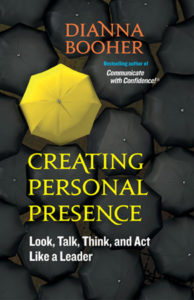


Whether delivering a presentation, delegating a project, or passing someone in the hallway, leaders get questions. Some challenging, some trivial. But all responses leave an impression: As a leader, you know that people either trust you for the truth—or think less of you than before they asked.
Remember that not all briefings, presentations, or speaking sessions should incorporate a formal question-and-answer period. Again, that’s a strategic decision. Consider the benefits and risks of allowing questions. The benefits include:
—finding out what’s on your listeners’ minds so you can tailor your remarks
—discovering and addressing any objections to what you’ve said
—demonstrating your depth of expertise as you answer
But of course, the risks of allowing a formal Q&A during a presentation are great too: Those who ask questions
—can bring up negative issues you may not want aired
—can set up a hostile atmosphere by disputing your data or facts
—can take up your time on trivial matters and distract from your primary message
So weigh the issue carefully about whether or not to allow questions if you’re doing a formal presentation or briefing.
If you ask for questions, pay attention to phrasing. “What questions do you have?” presumes and welcomes questions. “Are there questions?” (together with closed body language) can communicate that you don’t actually want questions.
Also, avoid statements like, “I’ll take two more questions.” What if your group has only one more question? The silence creates the impression that the group isn’t all that interested in what you have to say.
Or worse, what if the second question is negative? You certainly don’t want to end on a negative or sensitive issue. When you’ve decided to stop taking questions, just stop. No need to give a warning.
Never end with questions. Always deliver your polished wrap-up comments after any informal Q&A session. Otherwise, your presentation or speech simply limps to a close. You always want to end with a high-impact wallop, not a whimper.
Never approach an audience, expecting a confrontational atmosphere. Granted, conflict may develop with one or more of the attendees. But never begin the session by creating that atmosphere yourself.
Standing behind a lectern or table creates a barrier that separates you for the group and creates emotional distance. Guard against stiffening your body language or grimacing as you respond to a negative question. Be mindful not to dodge tough questions with vague, generalized answer rather than straightforward responses.
Nothing showcases your expertise, attitude, and character like handling tough questions well. Being responsive to questions shows approachability, humility, and concern. Take care not to destroy all these benefits by an abrupt response that shuts people down—sometimes, for good.
Leadership is all about open communication—input as well as outgo. Consider questions part of the input process.
For more thoughts on leadership communication and presentation skills, grab a copy of Creating Personal Presence: How to Look, Talk, Think, and Act Like a Leader.
